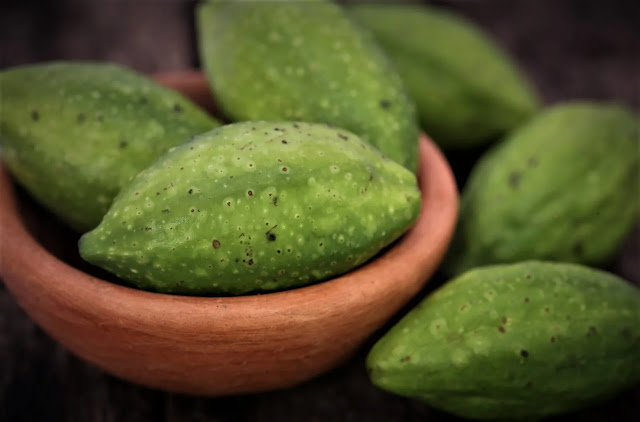Amalaki is called as Indian gooshberry. It is one of the Triphala, commonly used in the preparation of Ayurveda formulation. It is most used Ayurvedic ingredients. It is both used as food and as medicine. The Amalaki name itself from the word amla which mean sour. Amalaki fruit having sour taste, as the predominant taste.
|
Sanskrit name
|
Amalaki, Amalaka
|
|
Botanical name
|
Emblica
officinalis Gaertn.
|
|
Family
|
Phyllanthaceae
|
|
Vernacular name
-
English
-
Indonesia
-
Hindi
-
Kannada
-
Malayalam
-
Tamil
-
Bengali
-
Gujarat
-
Punjab
-
Assam
-
Manipuri
-
Marathi
-
Urdu
-
Arab
|
Indian gooshberry
Amla, amloko
Amla, Awla, Anwla,
Ambala, Amlika
Nelli, Nellikai
Nelli
Nellikkai,
Perunelli, Nellikaae
Aamla, Amla,
Aamalaki, Aamro
Aavla, Aamlam,
Aamli
Aamla, Ambalo,
Ambul
Amlaki, Amla,
Amlokhi, Amlok
Heikru
Aouli, Avalkati,
Avil, Avla
Aamla, Amal khushk
Amlakhushk
|
|
Part Used
|
Fruit pulp
|
|
Rasa (taste)
|
Amla (sour)
Madhura (sweet)
Kaṭu (pungent)
Tikta (bitter)
Kaṣaya (astringent)
|
|
Guna (properties)
|
Laghu (light)
Rukṣa (dry)
|
|
Vīrya (Potency)
|
Śīta (cooling)
|
|
Vipāka (metabolic effect)
|
Madhura (sweet)
|
|
Gaṇa (grouping)
|
Panca Kaṣaya
Triphala
Mustadi gaṇa
Paruṣakadi gaṇa
Amla skandha
Nikumbhadi gaṇa
|
|
Action
|
Rasayana (rejuvenating)
Vajikarana (aphrodiasiac)
Cakṣusya (eye tonic)
Vayasthapana (youth preserving)
|
|
Usage
|
Raktapitta (bleeding)
Amlapitta (gastritis)
Prameha (diabetes)
Daha (burning sensation)
Netra roga (eye disease)
Kusṭha (skin disease)
Arśa (hemorrhoids)
Rajayakṣma (Phthisis)
Pradara (leukoderma)
Mutra krcchra (dysuria)
|
|
Effect to body
|
Decrease vāta,
pitta, kapha
|
|
Chemical
content
|
Vitamin C
Carotene
Nicotinic acid
Myoinositol
Riboflavin
Fatty acids
Phyllembin
Phyllemblic acid
Mucic acid
Embicol
D-mannosyl
D-glucosyl
D-galactosyl
residues
Embicol
L-rhamnosyl
D-xylosyl
D-arabinosyl
Pectin
D-fructose
D-glucose
Leucodelphinidin
Procyanidin
3-O-gallated
prodelphinidin
Tannin (in bark)
Ellagic acid
Lupeol
Oleanolic aldehyde
O-acetyl oleanolic
acid
|
|
Distribution
|
India, Indonesia,
Sri Lanka, Nepal, and other tropical country
|
|
Morphology
Size
Leaves
Flowers
Fruits
Seeds
Tree Bark
|
Up to 8-18 meters
height
Simple, light
green, subsessile, resembling pinnate leaves.
Small,
greenish-yellow
Round, nearly
spherical, light greenish yellow, smooth, shining, presence of vertical
stripes.
Trigonous
Brown in colour
|
|
Products
|
Amalaki churna
Triphala churna
Baladya grita
Amalaki avaleha
Etc.
|
Amalaki
is tridoṣahara drug, means it give benefit to all tridoṣa or curing the disease
by imbalance of vāta, pitta as well as kapha.








